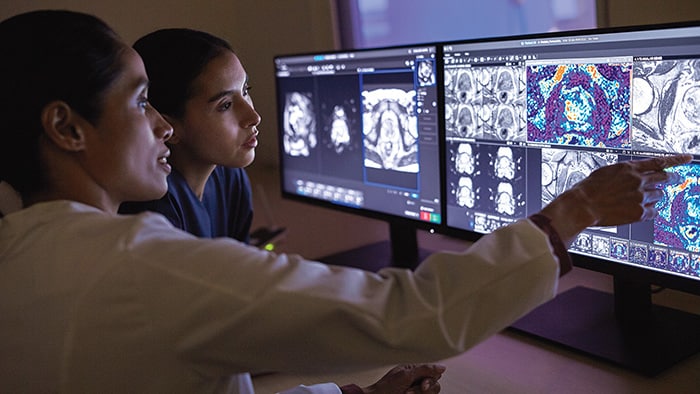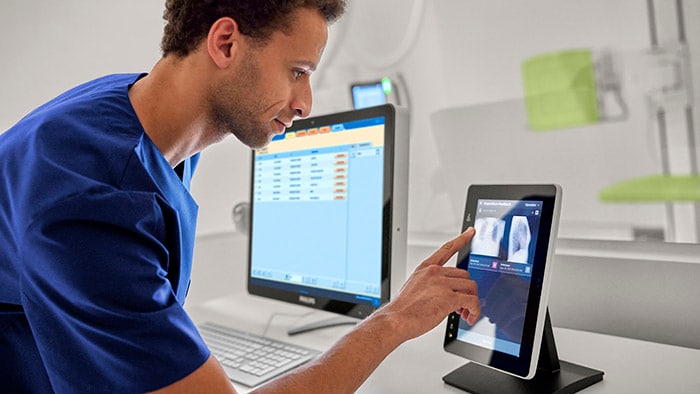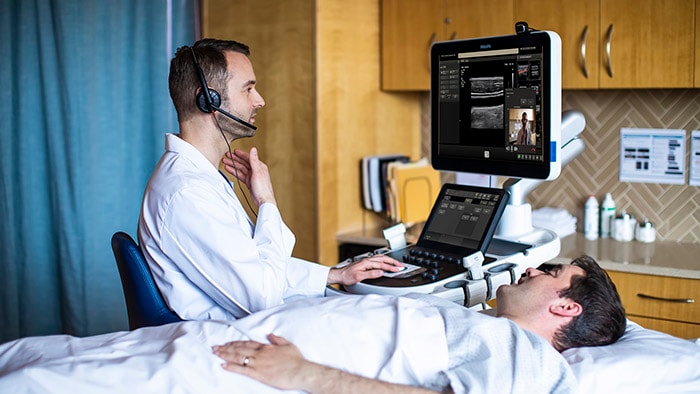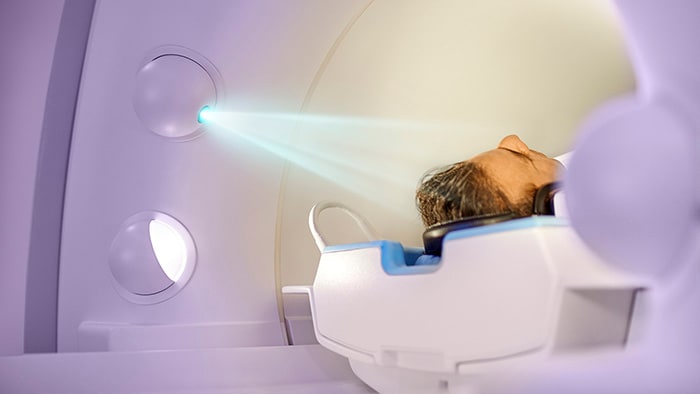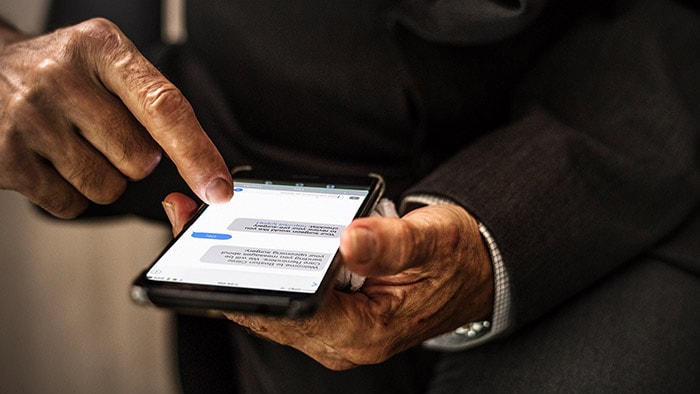Several weeks ago, I wrote about the role that imaging was playing in the triage of COVID-19 patients – discussing anecdotal learnings and raising questions to help guide radiologists and other imaging professionals during the pandemic. The modified American College of Radiology guidelines, as well as those of the Fleischner Society, recognize the difficulties posed by inadequate and imperfect COVID-19 testing; in many zip codes, imaging is the default option for stratifying patients into groups of likely, maybe and unlikely to be diagnosed with COVID-19. Since that post, COVID-19 has pressed on and, as more patients have been diagnosed and treated, we as an industry have observed and advanced our knowledge. The last few months are full of lessons learned as hospitals have grappled with caring for an unprecedented number of patients with limited staff and using only the technology within grasp. Imaging is often pivotal in guiding patient care, and COVID-19 is serving to reinforce widespread recognition of the value imaging offers in providing a confident diagnosis.
Lesson 1: Imaging can help as a screening modality – but no one size fits all
As the pandemic emerged, we lacked reliable, readily available testing. Imaging such as CT and ultrasound picked up the diagnostic slack in areas overwhelmed by probable COVID-19 during the hyper-acute phase of the virus – with little time to waste, imaging offered help, both for the triage of patients, and for quantifying their burden of disease. As we move into the next phases of the fight against COVID-19, how can we incorporate imaging into part of its treatment pathway, starting as a testing norm?
As we move into the next phases of the fight against COVID-19, how can we incorporate imaging into part of its treatment pathway, starting as a testing norm?
While many are putting their hopes on fast in vitro diagnostic testing solutions and vaccines, there’s a real and available opportunity to rethink the role of imaging as a tool for clinicians to sort patients rapidly. There are multiple modalities to consider for screening, diagnosing and monitoring COVID-19, but the reality is the imaging equipment per se is only one part of the equation – it also comes down to access, portability, ease of disinfecting, training and more. Take handheld ultrasound, for example. Many doctors, from critical care specialists to pulmonologists, may be familiar with handhelds, but by no means are all, meaning training becomes an important consideration. CT also has a role to play, and while we understand that there is a lag of approximately two days from the onset of COVID-19 to the evidence on CT, it should be considered as part of the diagnostic pathway. In addition to conventional CT, Spectral CT may offer a few advantages, both in terms of assessing unenhanced images and contrast-enhanced images. In particular spectral CT can take advantage of both lower dose of radiation and lower dose of iodinated contrast. With a single low dose scan, Spectral CT can allow radiologists to see more in one image, which is critically important when it comes to detecting pulmonary emboli that have become increasingly recognized as a common complication in COVID patients.

Lesson 2: Imaging can help improve the standard of care for everyone
In many markets, COVID-19 has exposed disparities in access to quality care and the impact that has on patient outcomes. It’s clear that differences exist that elevate the risk for COVID-19 diagnosis and death among certain groups in society. In short, one’s zip code has as much, if not more, to do with one’s outcome from COVID-19 than other, more typical considerations. So how can we address this disparity? When examining data from the last few months, we’ve learned that imaging can and should continue to serve as a first line of defense in areas where swab or blood testing continues to be problematic. As many parts of the world are experiencing an uptick in COVID-19 cases and as we prepare for a potential second wave of the virus, perhaps epidemiologists might look at the intersection of one’s zip code and whether imaging filled the void of accessible testing. For example, did those who had access to a CT scan early in their diagnosis have a better survival rate? To be prepared for the next situation, we need to ask ourselves many questions. Did hospitals in more rural areas have more success in controlling the virus because they used imaging early on? Importantly, are there lessons to be learned that might suggest how we could alter the approach to care in vulnerable populations? Just as we all are trying to flatten the COVID curve, we are also seeing a flattening of the imaging world.
Just as we all are trying to flatten the COVID curve, we are also seeing a flattening of the imaging world.
Understanding how to capture and read images outside of the radiology department isn’t just for EDs, pulmonologists or critical care docs. The reality is that AI is moving rapidly, and it is at least possible that COVID-19 pneumonia will be suggested by AI, either by CXR or handheld US, before patients undergo CT or before a radiologist sees the images. We may see a moment coming when we will see a return to the day when internists review images (pre-read by an AI algorithm) prior to a radiologist. Will AI be the difference that enables this flattening of the imaging world to improve access?
Lesson 3: AI adoption can improve already-strained workflows
COVID-19 heightened the need for streamlined workflows, particularly in the emergency department where patients are being triaged for both COVID and non-COVID related care. While autonomous AI solutions are still a long way off, this is an area where AI-powered imaging solutions that support physicians could make a big impact. Deploying AI in the imaging of patients could improve the identification and isolation of COVID-19 positive patients, helping to reduce the spread of the disease while also accelerating diagnosis for all patients. Such AI-driven workflows would also help to optimize both patient care and resource management. In addition, it is no longer uncommon for emergency medicine physicians to deploy ultrasound into their workflow. While initially operating in parallel to the radiology workflow, with images stored for billing purposes only on completely separate PACS; today, hospitals have merged these studies into the system-wide Radiology enterprise PACS, allowing for more integrated data flow. Another possibility is that AI could be deployed to review studies prior to study completion, to ensure all appropriate views are obtained. Regardless of whether an emergency physician or a radiologist ultimately interprets the study, AI could potentially serve as a quality check on the scan as much as it can on the quality of the interpretation. At a minimum, this could dramatically reduce the need for repeat scans. As only one department can bill for the imaging, the introduction of AI in this manner would help ensure the right images were obtained and interpreted correctly, avoiding the secondary round of images in Radiology.
Looking ahead with intention
Across much of the world, hospitals have been reopening their doors to non-urgent medical procedures and shifting out of crisis mode. Unfortunately, this shift is unpredictable as we continue to see spikes in some parts of the word, like the US and Brazil, where some of the re-opening measures are being rolled back. Perhaps, we can look at this as an opportunity to act on what we’ve learned and apply it toward a new era of healthcare. Imaging has always been at the center of a patient’s care pathway, as treatment cannot begin without a confident diagnosis, and this pandemic has only made imaging’s critical role increasingly evident. While society will remain focused on developing effective treatments and a vaccine, hospitals will continue to need help with detecting the virus, managing the patients who have it and mitigating its interference with elective surgeries and ongoing care. Imaging can’t solve each of these challenges alone, but it will be an important aspect to help health systems address some of the issues of the crisis and it’s up to us to apply these learnings.

Share on social media
Topics
Author
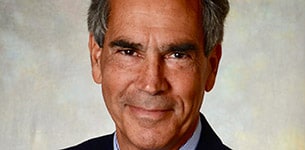
Chip Truwit, MD, FACR
Chief Medical Officer for Precision Diagnosis at Philips. Previously, Chip was previously Chief of Radiology and Chief Innovation Officer of Upstream Health Innovations at Hennepin County Medical Center, Minnesota, USA, and Professor Emeritus of Radiology at the University of Minnesota Specialist in neuroradiology with clinical interests in pediatric neuroradiology and intraoperative MR-guided therapy.



